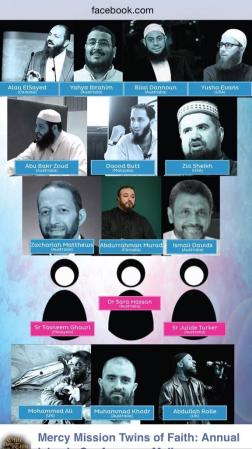 A brilliant site has been making the rounds of social media: allmalepanels.tumblr.com. I became aware of it just in time to suggest a post: an all-male symposium at Cambridge Muslim College on the future of the madrasa. The original article, since removed, touted its diverse participants, but as someone observed, clearly they only meant diverse styles of facial hair. The organizer apparently chose “to exclude women despite having had the matter brought to his attention” in the planning stages by male participants. (As of this writing, the college still has an all-male homepage.)
A brilliant site has been making the rounds of social media: allmalepanels.tumblr.com. I became aware of it just in time to suggest a post: an all-male symposium at Cambridge Muslim College on the future of the madrasa. The original article, since removed, touted its diverse participants, but as someone observed, clearly they only meant diverse styles of facial hair. The organizer apparently chose “to exclude women despite having had the matter brought to his attention” in the planning stages by male participants. (As of this writing, the college still has an all-male homepage.)
Right around the same time, I learned of an Australian Muslim conference taking a slightly different route, advertising an event with thirteen male speakers and three female ones. Not an ideal ratio, but certainly better than many events. What is troubling is the way men and women appear on the poster. Each man has a picture along with his name. The women are literally faceless, represented by identical balloon figures. While the men appear in color or grayscale photographs, the women are stark black and white, clearly inhuman caricatures. (Other similar events give slightly different lists with only one woman; she appears with different line drawings, one in profile and one “full face” – except, still, faceless.)

Two other things differentiate the female and male speakers. First, and in contrast to the way women are often stripped of titles, the men only get names, the women’s names are preceded by Sr. (“sister”) or, in one case, Dr.
Second, the men’s names are presented in blue, the women’s in pink.
Perhaps the aim was to represent some timeless Muslim notion of female modesty, in which women’s faces should not appear publicly. What we have instead is a clear illustration of precisely how modern – and in key respects, Western – particular gender ideals are. Pink for girls and blue for boys is a twentieth century American invention.
This poster illustrates, brilliantly, the confluence of disparate patriarchal systems of gender differentiation and male privilege. Here, just as in a workshop on the madrasa in a storied European university town, “Islam” and “the West” present not opposed but overlapping and intersecting systems of dominance.
The #allmalepanels tumblr reveals more of the same. National borders do not constrain. There are government symposia. There are award ceremonies for creative fields. There are panels, keynote panels, and entire conferences comprised of all-male experts.
Those who treated the all-male Saudi conference on women’s rights held in 2012 as laughable were, of course, justified. But in a nation whose leaders have cynically exploited Muslim women’s suffering to justify military interventions, we have numerous examples of men alone celebrating legislation affecting women’s lives. No country, ethnicity, religion, or professional field has a monopoly on patriarchy (though many all-male panels are also all-white).
Sara Ahmed has pointed out that “When you expose a problem you pose a problem.”
Part of the problem is perception.
Noticing a problem (“Hey, there don’t seem to be any women invited to a discussion of the future of Muslim education”) is a legitimate recognition of troubling power dynamics. It is perceived, though, by those who want the exclusion to go unnoticed, or at least unspoken, as a matter of hurt feelings: you imagine this is a problem because you weren’t included.
Women, this approach says, are not rational actors capable of analyzing larger patterns of exclusion and structures of domination, but rather irrational actors prone to hysterical overreaction to unintentional slights. (This notion of women as overly emotional and insufficiently rational is, by the way, also a joint production: though it figures regularly in certain strands of Muslim writing, it gets there via nineteenth and early twentieth-century European “scientific” discourses about femininity.)
Like pointing to women’s wounded feelings, focusing on the benign intent of those who exclude women deflects attention from patterns and structures. One can attend to how any particular event came to have no women represented (check out “female conference speaker bingo” for common excuses). But it is precisely the predictable nature of these perceived obstacles that makes them possible to overcome, if there is any sincere desire to do so.
Meanwhile, if you have not read Ahmed’s essay, now is the time. And next time you come across an all-male panel, or edited volume, or bibliography, send it along to allmalepanels.tumblr.com. If nothing else, it allows us to conjoin anger with laughter.
Kecia Ali, Ph.D. is an Associate Professor of Religion at Boston University where she teaches a range of classes related to Islam. She writes on early Islamic law, women, ethics, and biography. Her newest books are The Lives of Muhammad and the co-edited Guide for Women in Religion, revised edition. Her earlier books include Sexual Ethics and Islam: Feminist Reflections on Qur’an, Hadith, and Jurisprudence(2006),Marriage and Slavery in Early Islam (2010), and Imam Shafi’i: Scholar and Saint (2011). She currently serves on the Membership Task Force of the American Academy of Religion and serves as president of theSociety for the Study of Muslim Ethics. She lives in the Boston area with her family.


Those 3 female avatars? robots? really are too much. Allwomen not only are allthesame but we are allwithoutfaces as well? What century is this?
LikeLike
The females also appear to lack necks.
LikeLike
Maybe so as not to interfere with the womb-brain connection?
LikeLike
Carol, I hadn’t thought robots, but you’re absolutely right. No humanity.
LikeLike
Excellent essay, and omigoddess, the poster is horrible.
LikeLike
Thanks, Max.
LikeLike
Misogyny is obviously alive and well. Just read an article about sales tax on tampons in Australia, but not on condoms…
http://www.bbc.co.uk/news/world-australia-32879768
LikeLike
Reminiscent of US insurers who for a while covered Viagra but not birth control … but at least that led to changes. http://www.nytimes.com/1999/06/30/us/insurance-for-viagra-spurs-coverage-for-birth-control.html
LikeLike
That poster is a strong illustration of male immaturity around women. I remember a time when we women were told not to look into a man’s eyes lest he be seduced, to cover every bit of skin, etc. As one sister stated: “it’s time men grew up and took responsibility for their own thoughts and actions”. But we seem to be going backwards, or maybe it’s the public display of resistance before change happens? But that poster is really insulting, to all people male and female. Time to visit the website and stir up a laugh!
LikeLike
I this the idea that reactions like this are a precursor to change.
LikeLike
Love the bingo card! Thanks for writing this. It’s obviously not just a Muslim problem, though. I wish more Muslim women would shed the “modesty” and get out of the scarves and long sleeves and be themselves. For a lot of women in the West, I guess the scarves and long sleeves are invisible, but they’re still effective in hiding smart women.
LikeLike
Thanks, Barbara. That bingo card is terrific., isn’t it? There’s also a racism bingo card making the rounds: https://twitter.com/WritersofColour/status/602910076635078657/photo/1 (There are other versions, too.)
I am not quite sure what you mean about Muslim women not being able to “be themselves” with scarves and long sleeves. It seems to me that the inability to recognize a smart woman because of how she is dressed – be that modestly or immodestly (both of which are in the eye of the beholder) – is part of a larger problem of judging women based on appearance.
________________________________
LikeLiked by 1 person
Full agreement on both points!
For some Muslim women, wearing scarves and sleeves is a part of being themselves, so I don’t really understand your point, Barbara.
And yes, it’s not only a Muslim problem. Generally, men -or more specific, upper or middle class straight white cisgendered European, North-American or white Australian and/or New Zealand men- are considered “the norm” for being human, even in medicine, for instance.
Medicines are mostly tested on white adolescent men, even though because of DNA and gender variations, those same medicines can work out quite differently for women and/or people of colour…….
LikeLike
Reblogged this on Adventures and Musings of an Arch Druidess.
LikeLike
Right on the dot Kecia! Again slighting does not only happen in conferences but also within other Islamic circles.
However, this slighting also plagues higher Ed institutions on more subtle levels: e.g. The schools’ PR personnel exposing only male faculty as the “experts”, differences in pay….etc.
LikeLike
Deina, you’re absolutely right; this is by no means just a problem of panels. You might be interested in this recent round-up of scholarship on gender bias in academia, with annotated bibliography: http://www.hastac.org/blogs/superadmin/2015/01/26/gender-bias-academe-annotated-bibliography-important-recent-studies
LikeLike
You know me, what can I say but that this is BOSS! I posted it on Facebook and was asked by a non-Muslim male friend (of the Libertarian sort) if this wasn’t just more whining by women when they should just go organize their own stuff. I explained that women do organize their own panels and conferences but that it can end up serving an exclusionary purpose if it does not become a way for women to get into and affect the systems of power that are, at the moment, controlled by men. I think he got it. Now if he were only Muslim….we’d have made some progress there. lol. But I do think men are getting it. At least some men seem to be getting it is a PR liability. And maybe that’s the best we can hope for at this point.
LikeLike
Laury, thanks. Yes, there’s that “women are whining” thing, as if it’s just a question of our (over)sensitivity. And your point about the PR liability is a good one. I would hope that, even if cynically motivated to begin with, integrating women and women’s insights will illustrate how much richer and more productive conversations are when half the population is not excluded.
LikeLike
I agree that patriarchy should be criticized wherever found. But I disagree with your apparent equation of Western patriarchy with patriarchy in the Islamic world. That is to confuse grey with black. For example, a 2014 ranking of nations on a whole range of women’s rights (The Global Gender Gap Report) did not mention religion, but one can see for oneself that 18 of the bottom 20 nations are Muslim-majority. Suggesting that there are no distinctions and that the West is just as bad in this area as the Islamic world is just wrong and helps no one.
Here is the report: http://reports.weforum.org/global-gender-gap-report-2014/
Here is the report ranking: http://reports.weforum.org/global-gender-gap-report-2014/rankings/
A quick glance at the 2016 ranking shows very similar results.
LikeLike
Oh, boy. This reminds me of an all male panel I saw on Fox News discussing if women’s ordination should be allowed. They had a priest, a rabbi, a Muslim cleric, and evangelical ministers who were all male. Not one woman from a denomination or religion that supports women’s ordination or is a minister herself. Of course none of the men on the panel were in favor of women’s ordination in his religion. Not one woman or even a pro woman ordination male for a different perspective. I was outraged!
LikeLike